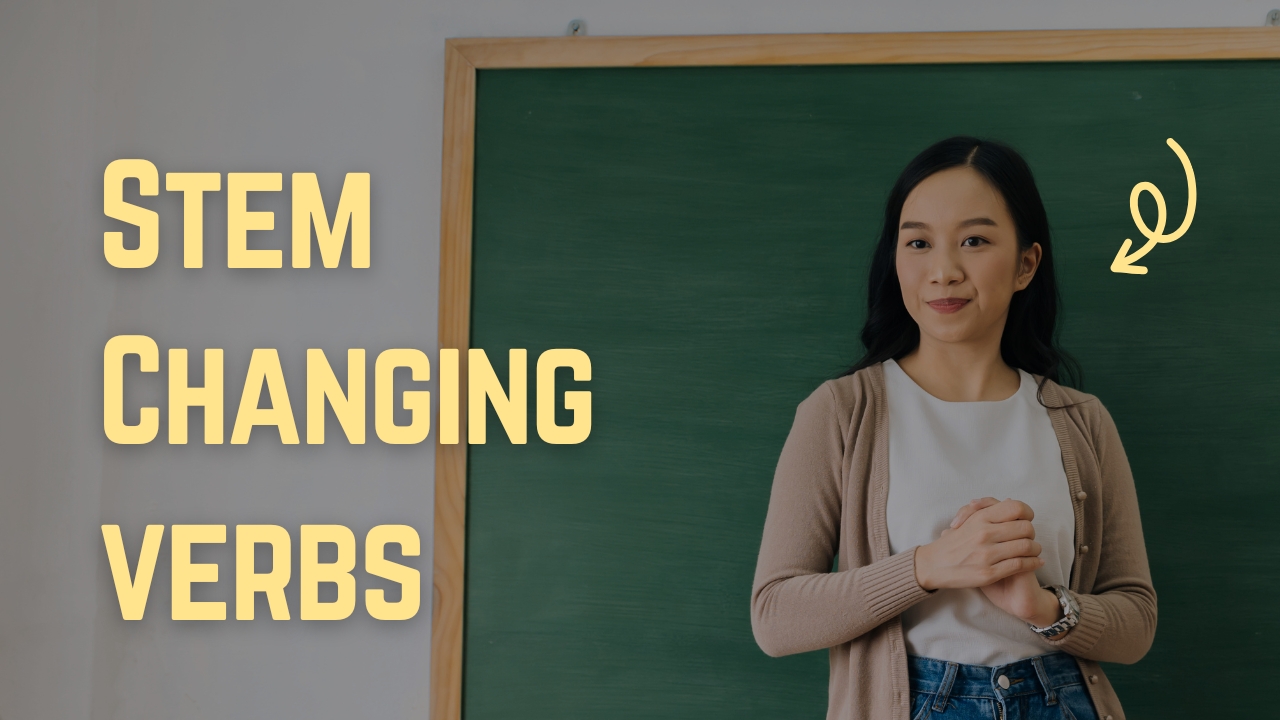The Stem Changing Verbs Spanish Chart is a crucial tool if you’re trying to get the hang of Spanish verb conjugations, especially if Spanish isn’t your first language. This chart shows how some Spanish verbs change their stem, or the main part of the verb. Understanding these changes is key to speaking and writing Spanish correctly. For example, the verb pensar (to think) changes from e to ie. This shift is not just about sound; it affects how the whole sentence comes together.
But here’s the thing: having the chart is one step. You also need to think about how these verbs play out in real-life conversations. How do these changes affect the meaning in different sentences or situations? It’s a big topic that can change how you use these verbs across various times and settings in Spanish.
How to Conjugate Regular Verbs
Conjugating regular Spanish verbs is pretty straightforward.
First, figure out the verb group—whether it ends in -ar, -er, or -ir.
Next, pick the tense you need, like present, past, or future.
Now, just add the right endings to the verb’s stem based on who’s doing the action.
The good thing is, regular verbs keep their stem the same in all forms, making it easier to learn and apply across different subjects.
| Verb Form | -AR Verbs (Bailar – To Dance) | -ER Verbs (Beber – To Drink) | -IR Verbs (Escribir – To Write) |
|---|---|---|---|
| Yo | bailo | bebo | escribo |
| Tú | bailas | bebes | escribes |
| Él/Ella/Usted | baila | bebe | escribe |
| Nosotros/as | bailamos | bebemos | escribimos |
| Vosotros/as | bailáis | bebéis | escribís |
| Ellos/Ellas/Ustedes | bailan | beben | escriben |
Stem-changing verbs in the present tense
Stem-changing verbs in Spanish change their vowels when you conjugate them in the present tense. The vowels change like this:
- e changes to ie
- u changes to ue
- o changes to ue
- e changes to i
It’s important to get these changes right. They help you speak and write Spanish correctly. Knowing these patterns helps you communicate clearly and correctly in everyday Spanish.
E to IE
In the present tense, a lot of Spanish verbs change a bit. The letter ‘e’ in the stem turns into ‘ie’. This switch is key for saying the verbs right.
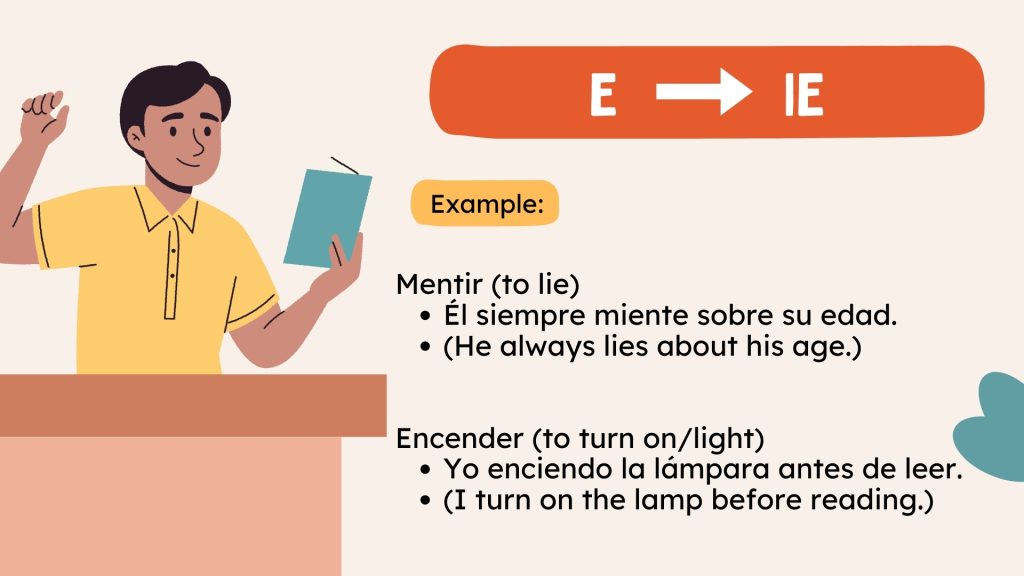
For example, verbs like cerrar (to close), empezar (to begin), and pensar (to think) all follow this rule. It really makes a difference in how they sound and what they mean when you’re talking.
| Verb Form | Querer (To Want) | Entender (To Understand) | Preferir (To Prefer) |
|---|---|---|---|
| Yo | quiero | entiendo | prefiero |
| Tú | quieres | entiendes | prefieres |
| Él/Ella/Usted | quiere | entiende | prefiere |
| Nosotros/as | queremos | entendemos | preferimos |
| Vosotros/as | queréis | entendéis | preferís |
| Ellos/Ellas/Ustedes | quieren | entienden | prefieren |
U to UE
In Spanish, some verbs change a bit when you use them in the present tense. The letter ‘o’ in these verbs turns into ‘ue’.
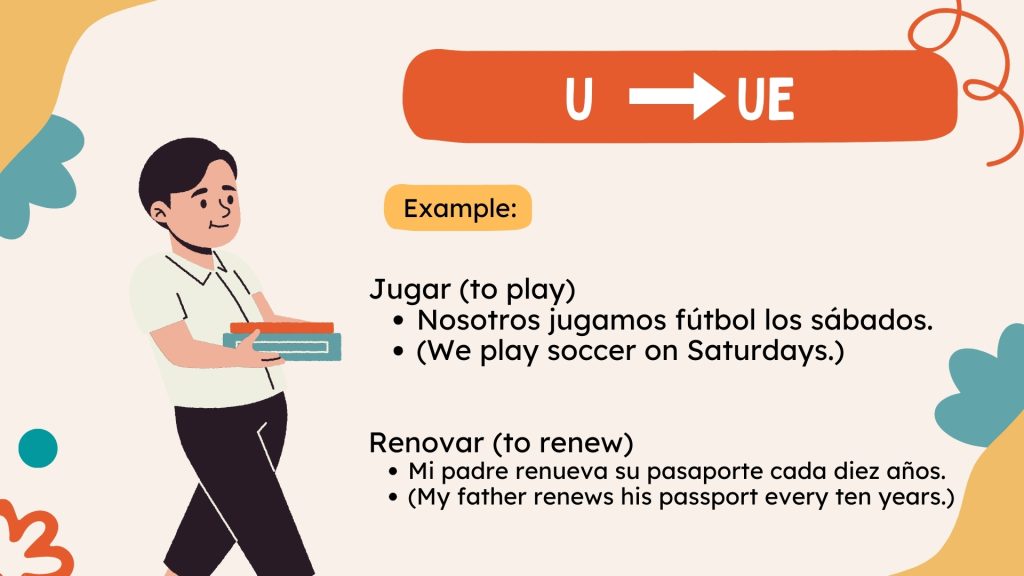
Knowing how to switch these letters correctly is really important. It helps you speak and write Spanish more fluently.
| Verb Form | Jugar (To Play) |
|---|---|
| Yo | juego |
| Tú | juegas |
| Él/Ella/Usted | juega |
| Nosotros/as | jugamos |
| Vosotros/as | jugáis |
| Ellos/Ellas/Ustedes | juegan |
O to UE
In Spanish, some verbs change a bit when you use them in the present tense. Take the verb ‘dormir,’ for instance. Instead of the ‘o’ in ‘dormir,’ you say ‘ue,’ so it becomes ‘duermir.’
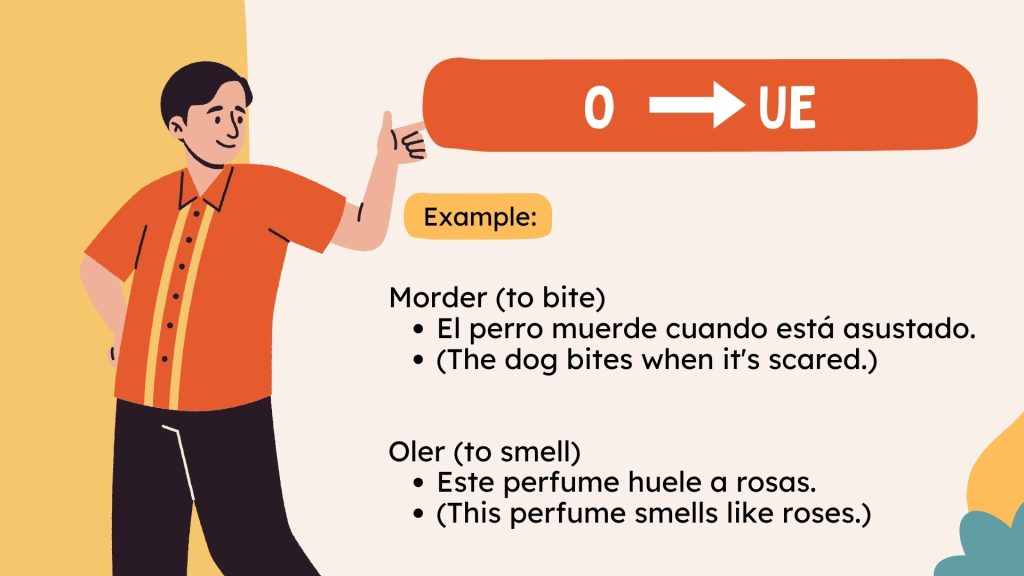
For example, when you want to say ‘I sleep’ in Spanish, you say ‘yo duermo.’ This kind of change is common with verbs that end in -ir and -er. Even with these changes, the way you conjugate the verb stays the same.
| Verb Form | Dormir (To Sleep) | Poder (To Be Able To) | Volver (To Return) |
|---|---|---|---|
| Yo | duermo | puedo | vuelvo |
| Tú | duermes | puedes | vuelves |
| Él/Ella/Usted | duerme | puede | vuelve |
| Nosotros/as | dormimos | podemos | volvemos |
| Vosotros/as | dormís | podéis | volvéis |
| Ellos/Ellas/Ustedes | duermen | pueden | vuelven |
E to I
Just like the O changes to UE in some verbs like ‘dormir,’ verbs like ‘pedir’ switch the E to I when you conjugate them in the present tense.
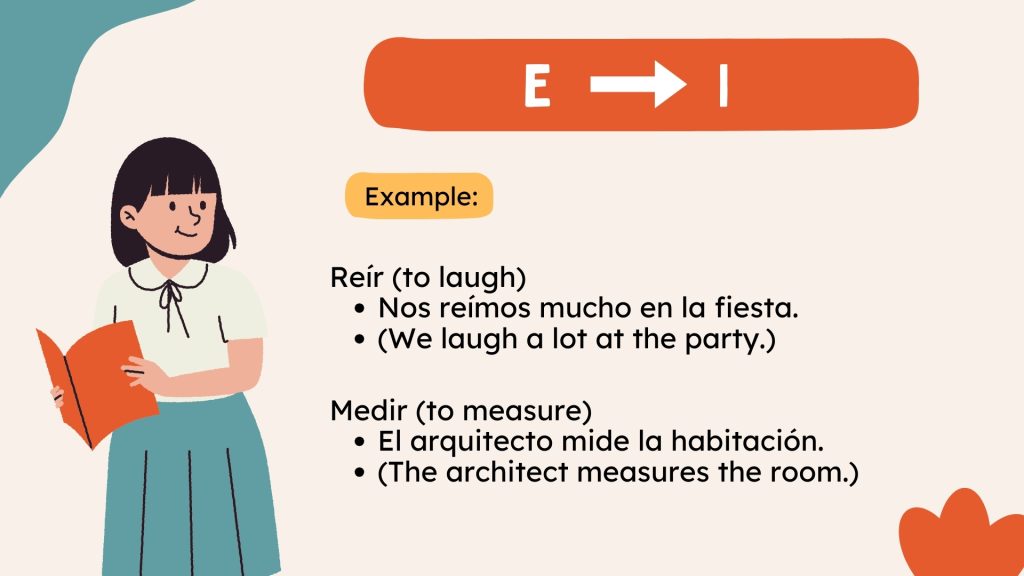
This happens in quite a few -ir verbs, so it’s good to know how they change to keep your sentences correct.
For instance, verbs like ‘servir’ and ‘repetir’ follow the same pattern.
| Verb Form | Pedir (To Ask For) | Servir (To Serve) | Repetir (To Repeat) |
|---|---|---|---|
| Yo | pido | sirvo | repito |
| Tú | pides | sirves | repites |
| Él/Ella/Usted | pide | sirve | repite |
| Nosotros/as | pedimos | servimos | repetimos |
| Vosotros/as | pedís | servís | repetís |
| Ellos/Ellas/Ustedes | piden | sirven | repiten |
How to Identify Spanish Stem-Changing Verbs
To spot Spanish stem-changing verbs, just look at the last vowel in the verb’s stem. This vowel will tell you how the verb morphs when you conjugate it.
The usual shifts are from e to ie, o to ue, and e to i. These changes generally occur right before the verb’s last syllable, and they really shape how you conjugate the verb in different scenarios.
• Stem-changing verbs modify their vowel in certain forms (yo, tú, él, ellos), but not in nosotros or vosotros.
• The stem change happens only in the present tense (and some other tenses).
• The pattern looks like a boot or shoe in conjugation charts.
Find the perfect Spanish Words That Start With X
Stem Changing Verbs in Other Tenses
Stem-changing verbs don’t just change in the present tense; they also change in other tenses like the preterite and subjunctive.
In the preterite tense, the changes mostly happen in the third person.
In the subjunctive, the changes are pretty consistent across most forms, sticking to the pattern we see in the present tense. This helps keep the verbs recognizable and makes sure we’re conjugating them correctly.
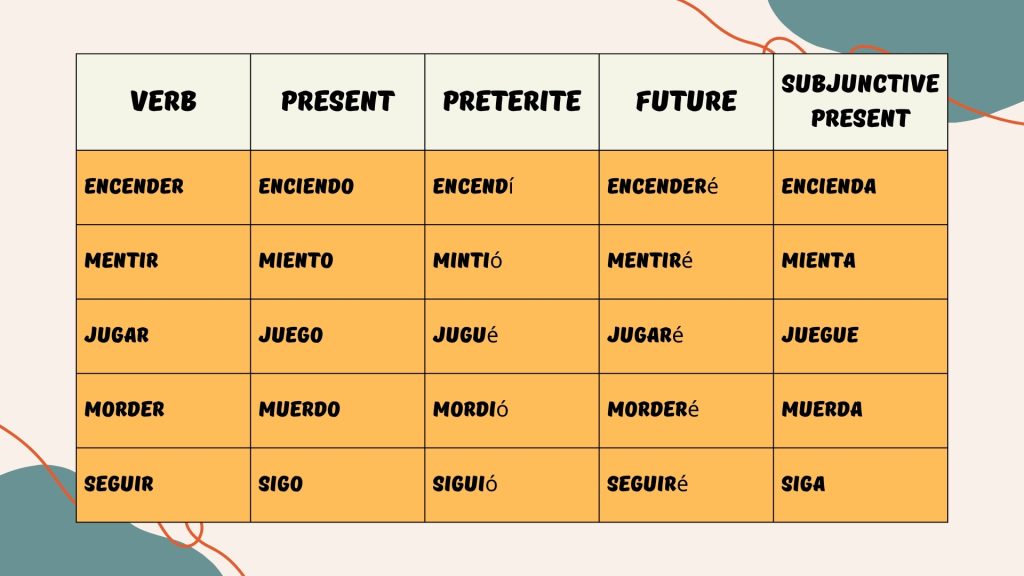
1. Present Tense (Boot Verbs)
• Change happens in all forms except nosotros/vosotros.
• Types of changes:
- E → IE (Querer → quiero)
- O → UE (Dormir → duermo)
- E → I (Pedir → pido)
- U → UE (Jugar → juego)
2. Preterite Tense (Only -IR Verbs Change)
• Only -IR verbs change in third-person forms (él/ellos).
• Types of changes:
- E → I (Pedir → pidió, pidieron)
- O → U (Dormir → durmió, durmieron)
✅ Example (Pedir – E → I)
| Subject | Conjugation |
|---|---|
| Yo | pedí |
| Tú | pediste |
| Él/Ella/Usted | pidió ✅ |
| Nosotros/as | pedimos ❌ |
| Vosotros/as | pedisteis ❌ |
| Ellos/Ellas/Ustedes | pidieron ✅ |
3. Present Subjunctive (Same as Present, But -IR Verbs Change in Nosotros/Vosotros)
• -AR & -ER verbs follow present tense rules (no change in nosotros/vosotros).
• -IR verbs change in all forms, including nosotros/vosotros, but with a single vowel shift:
- E → IE becomes E → I
- O → UE becomes O → U
✅ Example (Dormir – O → UE, but O → U in nosotros/vosotros)
| Subject | Conjugation |
|---|---|
| Yo | duerma |
| Tú | duermas |
| Él/Ella/Usted | duerma |
| Nosotros/as | durmamos ✅ |
| Vosotros/as | durmáis ✅ |
| Ellos/Ellas/Ustedes | duerman |
Conclusion
To put it simply, if you want to get good at Spanish, you need to nail down stem-changing verbs. These verbs shift their vowels in the stem when you change tenses, which helps you get the conjugation right.
Knowing these shifts makes you pronounce the words correctly and helps you communicate better. If you use a clear chart and really get to know these rules, you’ll find it way easier to understand and speak Spanish, whether it’s in writing or out loud.
Keep reading, keep growing—only with Lingua Viva.
Carolina is a charming and lively member of Lingua Viva with 11+ years of teaching experience. She loves to teach students appropriate ways to communicate effectively in Spanish without the fear of making mistakes. She holds a professional teaching license and has a graduate degree with emphasis in Foreign Language.
